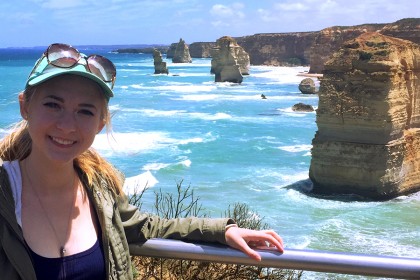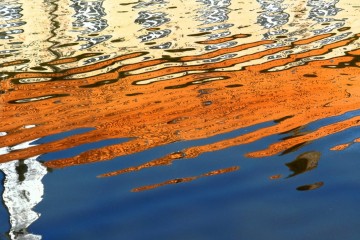This piece of fiction was written with inspiration from Gabriel Garcia Marquez's short story, "A Very Old Man with Enormous Wings" and "Mermaid Fever" by Steven Millhauser. In each class meeting of the Intersession course Writing Fantastical Fiction, taught by Johns Hopkins creative writing instructor Shannon Robinson, students are assigned to read a selection of short stories and submit a short writing assignment that responds to the readings.
There were whales on the lawn again.
They'd started coming last February, these great beasts falling from the sky and landing with heavy thuds in parking lots, trees, rooftop pools. First it had been the smaller whales; orcas, minkes, a beluga or two. The news had been all over it. Reporters had swarmed the town like locusts, eating up every bite of information they could get their hands on. There wasn't much. The whales fell, on cloudy days, usually, and landed wherever gravity deemed fit. The electricians worked overtime, repairing poles and wires knocked down by the falling whales. Insurance companies went haywire trying to provide as little support as possible to those whose cars and homes had been destroyed in this unprecedented natural event. Top meteorologists and marine biologists met across the country to try to figure out what was happening, but not one team could posit anything more than a weakly-defined theory about wind patterns and rising sea levels. A few unlucky people found themselves in the wrong place at the wrong time and were crushed under the tons of blubber that had descended upon them more quickly than they could run away.
When, after a few months and a few more casualties, the reporters finally retreated, the bigger whales started falling. A gray whale was the first to makes headlines as "The Biggest Precipitated Whale Yet!" Then the bowhead whales came, and then the sperm whales. By the time the first big blue fell, crushing a movie theatre and the fifty people watching Jaws inside of it, the event barely made the county news.
The trouble became what to do with them. The majority of the whales, understandably, died on impact. Those that didn't soon died of dehydration and the incredible pressure a waterless environment presented. Some dark comedians pointed out that, though the whales were crushing our institutions, our world was also crushing them. One lucky humpback landed in a Seaworld, though this too caused national debates, as many considered the minuscule tank a fate worse than death.
Initially, museums and research facilities had practically begged to be allowed to retrieve the corpses from the city streets. The town happily complied, lacking the infrastructure for a city-run whale removal team. Museums across the nation flew in and harvested their decaying bounty, and soon nearly every institution that wanted one had a whale. The Smithsonian was quick to publicize its unprecedented "complete set." But the sky kept providing whales, and soon the situation became so desperate that most museums blocked every number from the town's area code and released statements declaring their sufficient stock of bones. Locals tried to do what they could to push the whales back into the sea, but no amount of men could push a hundred-ton brick of blubber even a fraction of an inch. As the smell of rotting flesh and the destruction of property continued, many residents tried to seek asylum in neighboring towns or states. The rest of the country, however, had developed a superstition surrounding the entire situation and feared that the onslaught of whales would follow wherever their initial victims went. Insurance companies vowed to rescind the policies of anyone living within a three-mile radius of a whale escapee. The president was forced to declare a state of emergency and instituted a one-way quarantine on the town.
And still, the whales kept coming.
About the author

Image credit: Molly Kamicar
Molly Kamicar is a Johns Hopkins University senior and has a major in the Writing Seminars with a minor in psychology. Kamicar said she took the Writing Fantastical Fiction Intersession course because she's always been particularly interested in magical realism. This class was the first Intersession course she has ever taken.
Posted in Arts+Culture, Student Life
Tagged intersession, fantastical fiction











